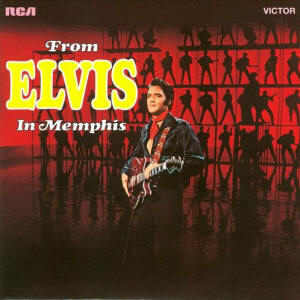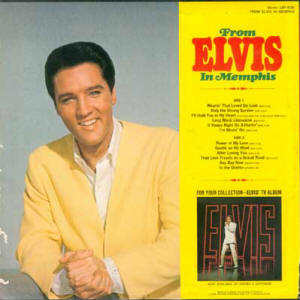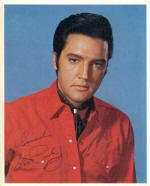

With "From Elvis In Memphis" the king
released his first studio album in two years.
The record was sent out to the stores in early
June 1969 and was listed on Billboard's "Top LPs
Chart" for the first time on the 14th of the
month. It had a run of 34 weeks and peaked at
number 12. On June 21st "From Elvis In Memphis"
also entered the "Hot Country LPs Chart", where
it was also listed for 34 weeks, but reached
number 2. In its initial sales period 500,000
units were retailed, in January 1970 the RIAA
honored the domestic sales with a Gold Award.
Worldwide "From Elvis In Memphis" sold 3.5
million units, which equals 525 million
paid streams of the complete album or 5.25
billion individual tracks. Therefore it was the
second album in a row that could compete with
the king's heyday. After the post-army comeback
Elvis was now obviously enjoying a third
commercial spring.
In 2016 the complete Presley catalogue was
restored and remastered by Vic Anesini for a
boxed set of 60 compact discs called "The Album
Collection". Sony Music Entertainment provides
the streaming platforms with the same versions
of the individual albums (in this case with
"Suspicious Minds", "Don't Cry Daddy", "Kentucky
Rain" and "Mama Liked The Roses" as bonus
tracks), albeit in 24 bit/90 khz flac. That
means, if the platform of your choice supports
high resolution audio, you can enjoy the tracks
in the same quality Sony used to scan and master
them. On Spotify, which has a market share of
approximately 30% and is the only platform that
publishes streaming figures, "From Elvis In
Memphis" accumulates over 860 million streams
and is requested more than 300,000 times per
day. Therefore "From Elvis In Memphis" belongs
to the most popular original Presley albums on
the platform.
The front cover was made up with a great shot
from the tv special "SINGER presents Elvis", but
on the backside RCA Victor unfortunately used a
six years old promo photo for "Viva Las Vegas",
which now looked like from another age. Of
course the label didn't forget to promote the
album "Elvis", which containes the soundtrack of
the tv show. To boost the sales the first
edition of "From Elvis In Memphis" included a
photocard with another promo shot for "SINGER
presents Elvis".


The album was produced in
two sessions at the American Sound Studio in
Memphis/Tennessee. The first period of recording
lasted from January 13th to 22nd, the second one
from February 17th to 22nd. The sessions were
produced by Chips Moman (American) and Felton
Jarvis (RCA) and engineered by Roy Shockley
(American) and Al Pachucki (RCA). The band
consisted of Reggie Young (guitar & sitar),
Tommy Cogbill (bass), Mike Leech (bass), Gene
Chrisman (drums), Bobby Wood (piano), Bobby
Emmons (organ), John Hughey (steel guitar) and
Ed Kollis (harmonica). Between January 22nd and
May 7th further instruments and harmony voices
were added. The masters were released on the
albums "From Elvis In Memphis" (1969) and "From
Memphis To Vegas / From Vegas To Memphis" (1969)
as well as on several singles (1969/70). The
leftovers appeared on "Let's Be Friends"
(CAMDEN, 1970), "Almost In Love" (CAMDEN, 1970)
and "Elvis Now" (RCA, 1972). Without the
additional tracks of the digital release "From
Elvis In Memphis" has a running time of 36:42
minutes.
In contrast to Elvis' old
fashioned ways Chips Moman didn't produce his
recordings as live tracks, but worked with
layers. The groundwork was a basic track, which
was later altered and enhanced in various ways.
Additional instruments and voices were recorded,
some parts were left out and others were
replaced. Since the king had started out in the
1950s, the technology had improved a lot and by
1969 the engineers had much more tracks
available. Even though he stayed silent at the
time, Elvis didn't like this way of recording.
He would never work with Moman again and
immediately returned to his tried and tested
formula.
In 2013 Follow That Dream
Records released a collector's edition of "From
Elvis In Memphis". Besides the remastered tracks
of the original album this double cd also
included a lot of previously unreleased
outtakes. To read a review of this release tap
HERE.
Wearin' That Loved On Look
The album starts with the line "I had to leave
town for a little while". And it was true,
indeed. For the first time since 1955 Elvis
recorded in Memphis again. The song, of course,
wasn't about putting songs on tape, but about
the singer returning home and having to realize
that his loved one had been partying all the
time and living at his expense."Wearin' That
Loved On Look" was written by Dallas Frazier and
Al Owens, the king recorded it on January 13,
1969 and selected the 15th attempt as the master
take. On January 21st Elvis re-recorded the
vocals, the following day a guitar overdub was
made. The post-production ended on January 24th
with the recording of harmony vocals.
Only The Strong Survive
The song was written by Kenny Gamble, Leon Huff
and Jerry Butler. The latter one also recorded
it and scored a top 5 hit with "Only The Strong
Survive" in 1968. Elvis taped his version on
February 19, 1969 and needed 29 takes to get it
right. On February 22nd the king recorded
several vocal repairs, Chips Moman later added
horns (March 18th), strings (March 21st) and
harmony vocals (March 25th). In the song the
singer tells us about his first, unlucky love and
the resulting advice from his mother: Keep your
tail up!
I'll Hold You In My Heart (Till I Can
Hold You In My Arms)
Elvis turns this classic in a mourning blues. It
was written in 1947 by Thomas Dilbeck, Vaughan
Horton and Eddy Arnold, whose performace stayed
at the top of the charts for an astonishing 21
weeks. Elvis recorded "I'll Hold You In My Heart
(Till I Can Hold You In My Arms)" on January 22,
1969 within a single take.
Long Black Limousine
This one was recorded on January 13, 1969, the
9th take was chosen for post production. The
first step was to re-record Elvis' vocals
starting with the line "through tear-filled
eyes...". This was done on January 22nd. Finally
strings were added on March 18th. In the song
the girlfriend of the narrator once promised to
return in a long black limousine and now the
time has finally come. But it soon turns out
that the limousine isn't a luxurious car, but a
hearse. Elvis performs the song in great voice
and very emotional. The arrangement is top
notch, too. In other words: This is a real
classic and my all time favorite in the
catalogue of the king! "Long Black Limousine"
was written by Vern Stoval and Bobby George.
Wynn Steward was the first to record the song,
but the first release was by Stovall himself.
The best known version at the time was by
country star Glen Campbell.
It Keeps Right On A-Hurtin'
The dramatical song is followed by a simple
country tune, which Elvis taped on February 20,
1969 within three takes. The violins were added
on March 21st, three days later harmony vocals
followed. In 1962 Johnny Tillotson, the writer
of "It Keeps Right On A-Hurtin'", enjoyed a
number 3 hit with his song, in 1968 Margaret
Whiting scored a top 20 hit. The lyrics are
typical for a country song, there is a lot of
pain because the loved one is gone. It's a nice
tune and Elvis performs it well.
I'm Moving On
When Hank Snow released "I'm Moving On" in 1950,
the song stayed at the number one of the country
chart for 21 consecutive weeks. Since then many
artists have covered the tune, examples are Ray
Charles, Emmylou Harris and The Rolling Stones.
Elvis recorded "I'm Moving On" on January 14,
1969 within a single take, five days later
producer Chips Moman added additional
instruments. On January 22nd Elvis re-recorded
most of his vocals, on January 24th the
production was finalized by overdubbing harmony
voices. The king performs the song with much
more drive than Snow, which I like better.
Power Of My Love
Bernie Baum, Bill Giant and Florence Kaye are
known for a truckload of mediocre movie tunes,
but "Power Of My Love" is a great example that
the trio was able to deliver really good stuff,
too. Full of power and testosterone the king
promotes his qualities as a lover and obviously
has fun with the song. It was recorded on
February 18, 1969 with take 7 (actually it was
the 8th attempt) being the master-take. On
February 22nd the king recorded a harmony vocal,
on March 19th and 25th horns and backup voices
were added.
Gentle On My Mind
The song was written and performed by John
Hartford, who won a Grammy with it in 1968. The
version by Glen Campbell was also awarded by The
Academy Of Recording Arts And Sciences. "Gentle
On My Mind" was a very popular song and covered
by Aretha Franklin, Dean Martin, Johnny Cash,
REM and many others. Elvis did so on January 14,
1969. Six days later he re-recorded major parts
of his vocals and also added the harmony voice.
Later brass (March 18th), strings (March 19th),
other instruments (March 20th) and backup voices
(March 25th) were overdubbed. In early 1977 RCA
Records released a remix of "Gentle On My Mind"
on the album "Welcome To My World".
After Loving You
Originally Elvis had planned to record "After
Loving You" a few years earlier, but he never
made it past a private recording for his own
use. He finally taped a version in a
professional environment on February 18, 1969.
The song was written by Eddie Miller and Janet
Lantz, the first recording was by Joe Henderson
in 1962. The same year Eddie Arnold released a
cover version, Jim Reeves followed a year later.
The narrator claims to be unable to love any
woman the way he loves his ex, because compared
to her all others are second rate. Elvis gets
completely caught up in his performance and
wrings out every ounce of emotion.
True Love Travels On A Gravel Road
Dallas Frazier and Al Owens wrote this song
about a love surviving all storms. Duane Dee
recorded "True Love Travels On A Gravel Road" in
1968, but never made it past number 58 of the
country chart. Elvis taped his version on
February 17, 1969 and performed it live on
January 26, 1970 in Las Vegas. The studio
recording was spiced up with the king recording
a harmony vocal (February 22nd) and the addition
of strings and backup vocals (March 25th). The
result is a strong, modern (by 1969) and mature
popsong.
Any Day Now
The basic track of "Any Day Now" was recorded on
February 20, 1969 within six takes. On February
22nd Elvis produced a vocal repair, horns and
strings were added on March 18th, harmony voices
followed on March 25th. The singer fears to be
left by his loved one any time and begs her to
stay. To me "Any Day Now" is one of the
highlights of this album. Elvis must have
thought in a similar way, because the song was
released on the b-side of "In The Ghetto". Chuck
Jackson was the first to record the tune in 1962
and his single peaked at number 23 of the "Hot
100". The writers of "Any Day Now" are Bob
Hilliard and Burt Bacharach.
In The Ghetto
Mac Davis describes the short life of a man in a
city slum, that ends violently in consequence of
a robbery. Because a baby is born at the same
time and its fate will be similar, the song
originally was sub-titled "The Vicious Circle".
On January 20, 1969 Elvis recorded 22 takes of
the ballad, but finally the track with his voice
was silenced and just the music was used. Two
days after the initial recording the king
produced a new vocal track, on January 24th
Chips Moman and Felton Jarvis added harmony
voices. The production was finalized on March
18th with the overdub of horns and strings. The
skilled arrangement and Elvis' emotional and
believable performance turn this ordinary and
simple consternation-tune into something very
special. No wonder, it was decided to make "In
The Ghetto" the a-side of a single. Just a few
months after the release of "From Elvis In
Memphis" RCA Victor issued a live recording of
"In The Ghetto" on the double album "From
Memphis To Vegas / From Vegas To Memphis". The
studio version was re-released on the boxed set
"Worldwide 50 Gold Award Hits - Volume 1" (1970)
and the longplayer "Pure Gold" (1975).
Verdict
Elvis continued in the vein of "If I Can
Dream" and "Memories" and presented himself
as a mature and modern popsinger. He had
obviously grown as an artist and the
selection of material couldn't have been any
better.

(C) RCA Records
![]()



